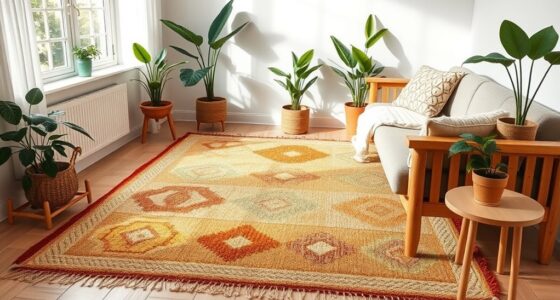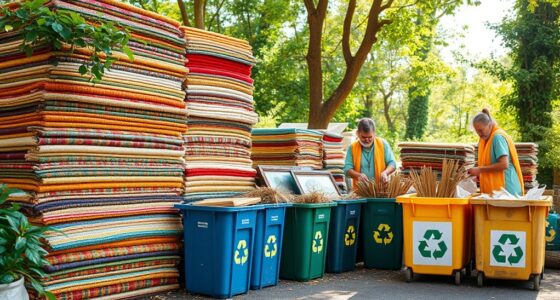To choose eco-friendly rug shipping and crating options, focus on sustainable materials like recycled wood, biodegradable cushioning, and natural fiber wraps. Opt for recyclable, reusable packaging and work with carriers committed to green logistics, such as electric or alternative fuel vehicles. Proper handling and storage also extend your rug’s lifespan, reducing waste. By making mindful choices, you can minimize your environmental impact while ensuring safe transport. Keep exploring to discover more sustainable practices.
Key Takeaways
- Use recyclable, biodegradable, or compostable packaging materials to reduce environmental impact.
- Opt for natural fiber wraps and recycled wood crating to promote sustainability.
- Choose carriers committed to eco-friendly practices, such as electric or alternative fuel vehicles.
- Consolidate shipments and plan efficient routes to minimize transportation emissions.
- Implement reusable packaging and cushioning solutions to lessen waste and support circular economy efforts.
Benefits of Choosing Eco-Friendly Shipping Methods
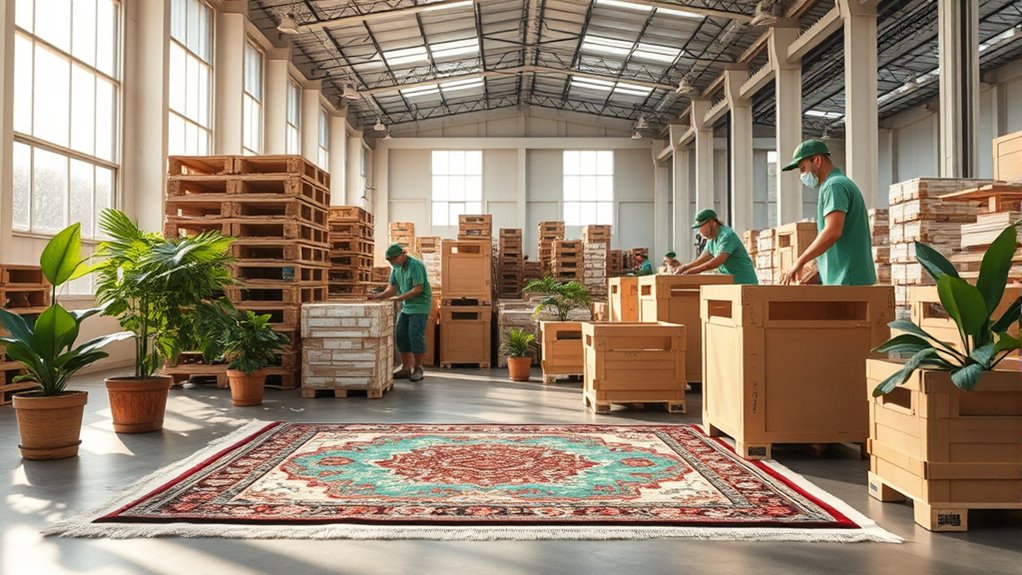
Opting for eco-friendly shipping methods offers several compelling benefits that can positively impact both the environment and your business. By participating in recycling programs, you reduce waste and promote sustainable resource use, showing your commitment to environmental responsibility. Additionally, carbon offsetting helps balance out the emissions generated during shipping, lowering your carbon footprint. These practices appeal to eco-conscious customers, enhancing your brand’s reputation and attracting loyalty. Eco-friendly shipping also encourages operational efficiencies, reducing costs over time. More companies are recognizing the importance of sustainability, and adopting green shipping practices demonstrates your proactive approach toward environmental stewardship. Incorporating anime movies into your marketing campaigns can further emphasize your dedication to innovative and culturally relevant initiatives. Additionally, choosing energy-efficient shipping options can significantly reduce overall power consumption and improve your company’s sustainability profile. Understanding sustainable logistics and implementing eco-conscious strategies can give your business a competitive edge and foster long-term growth. For example, utilizing carbon-neutral shipping methods can help your company achieve its environmental goals more effectively. Implementing green supply chain practices can streamline operations and reduce waste throughout your logistics network. Ultimately, these strategies help you build a responsible image, support global efforts to combat climate change, and contribute to a healthier planet.
Sustainable Materials for Rug Crating
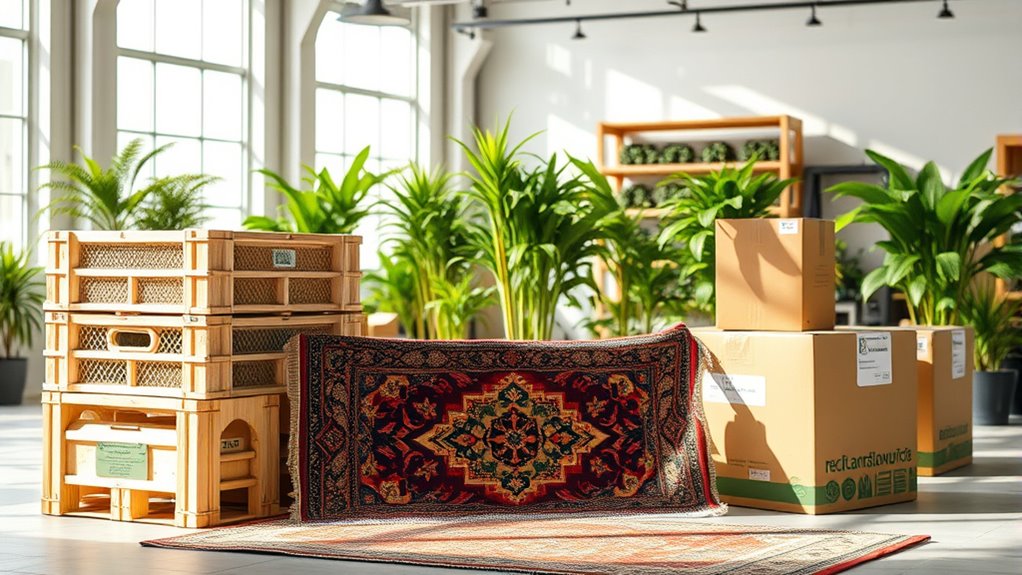
Using sustainable materials for rug crating helps reduce environmental impact and promotes eco-friendly practices. You can choose recycled wood packaging, biodegradable cushioning, or natural fiber wrapping options to make your shipping greener. These choices guarantee your rug stays protected while supporting a healthier planet. Incorporating self-watering plant pots principles, such as efficient resource use and moisture control, can inspire innovative packaging solutions that conserve materials and reduce waste. For example, integrating biodegradable cushioning techniques can further minimize environmental footprint by utilizing materials that naturally decompose. Additionally, selecting renewable resources for packaging components ensures a continual supply of sustainable materials, further enhancing your eco-conscious efforts. Emphasizing sustainable packing methods can lead to more effective and environmentally responsible shipping practices, aligning with broader conservation goals. Incorporating nutrient-rich ingredients in packaging design can further enhance sustainability efforts by utilizing natural and biodegradable components.
Recycled Wood Packaging
Recycled wood packaging offers a sustainable alternative to traditional crating materials, reducing environmental impact while protecting your rugs during transit. By using recycled wood, you minimize waste and give new life to materials that might otherwise end up in landfills. This approach aligns with packaging innovations designed to be both durable and eco-friendly, ensuring your rugs stay secure without sacrificing sustainability. Recycled wood crates are strong, customizable, and capable of withstanding the rigors of shipping. They also contribute to reducing deforestation and lowering carbon footprints. Implementing recycled wood in your rug crating process demonstrates a commitment to environmental responsibility. Incorporating float mounting textile art techniques can also enhance the presentation of your finished pieces, emphasizing the importance of sustainable display methods. Moreover, understanding the importance of cost-effective solutions can help maximize the benefits of reusable crates while managing expenses. Using reusable materials not only enhances sustainability but also offers long-term savings. Additionally, selecting materials that support renewable resources ensures your shipping practices remain aligned with eco-friendly principles. Plus, these crates are often reusable, making them a cost-effective and green choice for long-term shipping needs.
Biodegradable Cushioning Materials
Biodegradable cushioning materials are gaining popularity as eco-friendly options for rug crating because they break down naturally without harming the environment. These materials, such as cornstarch peanuts or mushroom-based packaging, provide effective protection during transit while reducing landfill waste. Eco-friendly fillers like biodegradable cushioning offer a sustainable alternative to traditional foam or plastic wraps, which can persist for decades. By choosing biodegradable cushioning, you help minimize your carbon footprint and promote responsible disposal practices. These materials decompose quickly when disposed of properly, turning into natural compost without releasing harmful chemicals. Incorporating biodegradable cushioning into your rug crating process demonstrates your commitment to environmental stewardship and ensures your shipments are both safe and sustainable.
Natural Fiber Wrapping Options
Building on eco-friendly cushioning, natural fiber wrapping options offer a sustainable way to protect rugs during transit. Unlike synthetic fibers, which often rely on non-renewable resources, natural fibers like jute, hemp, and cotton are biodegradable and renewable. These materials provide a breathable, protective layer that prevents dust and dirt from settling on your rug. Unlike plastic wrap, which is made from non-biodegradable materials, natural fiber wraps minimize environmental impact and reduce waste. They are sturdy yet flexible, making them easy to handle and secure around your rug. Choosing natural fiber wrapping not only safeguards your rug effectively but also aligns with environmentally conscious shipping practices, helping you reduce your ecological footprint without compromising on protection. Incorporating sustainable materials and vertical storage solutions can further optimize your space and enhance sustainability by reducing the need for excessive packaging and handling. Additionally, selecting biodegradable wrapping options ensures that your packaging decomposes naturally after use, further supporting environmental preservation. Practicing mindfulness about environmental impact during packing can also promote more sustainable shipping choices.
Eco-Conscious Packaging Techniques
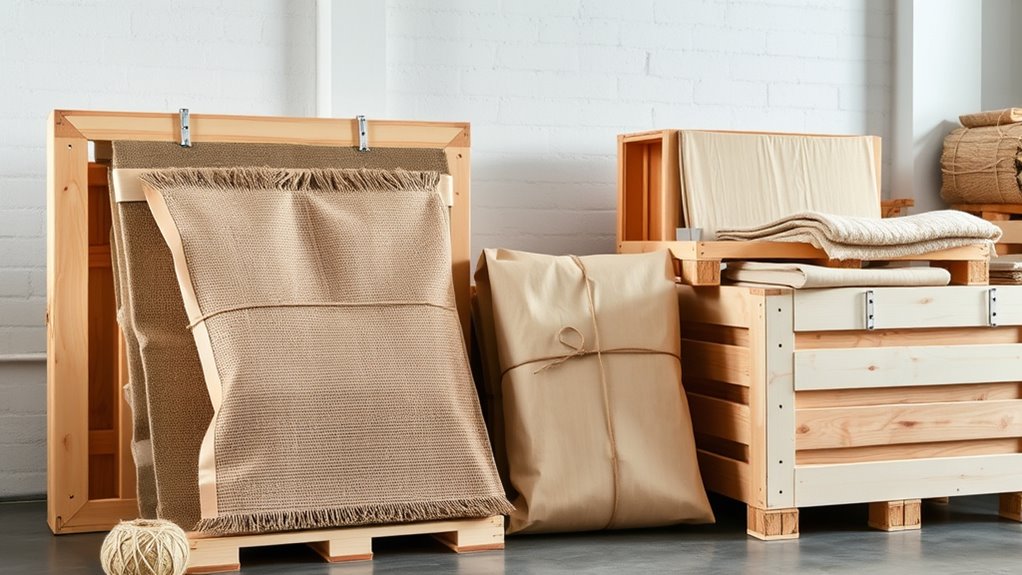
Choosing eco-conscious packaging techniques allows you to minimize environmental impact while ensuring your rugs arrive safely. Opt for biodegradable materials and avoid synthetic adhesives that can harm the planet. Use paper-based fillers instead of plastic-based fillers, which are less sustainable. Consider reusable packaging options to reduce waste. When sealing your rug, choose natural adhesives or water-based glues over synthetic adhesives for a greener choice. Additionally, select recyclable or compostable packing materials to further lessen your carbon footprint. By implementing these practices, you contribute to a healthier environment without sacrificing protection. Remember, small adjustments in your packaging methods can make a significant difference in eco-friendliness and sustainability.
Green Logistics and Transportation Options
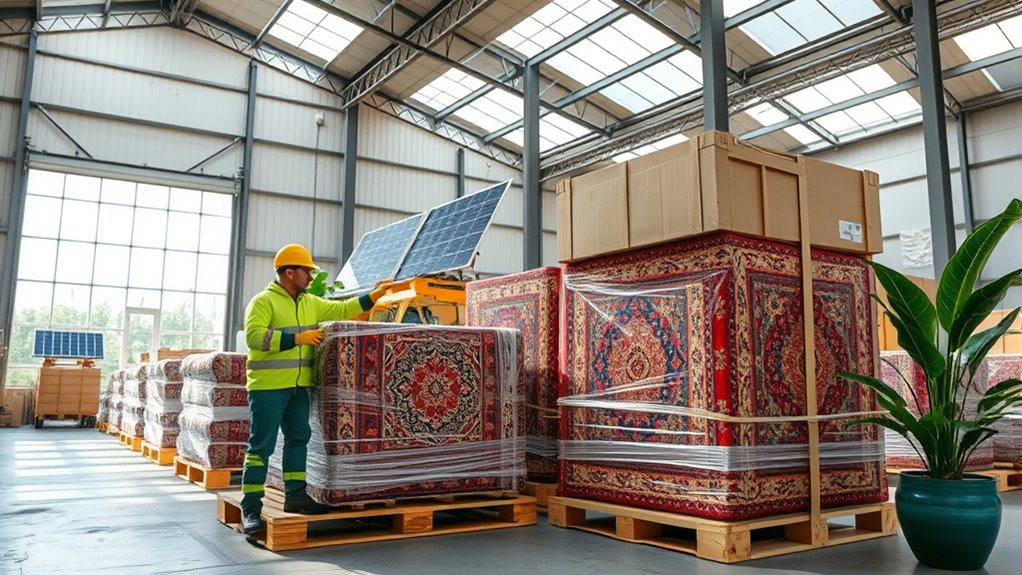
Implementing eco-conscious packaging techniques is a great step, but optimizing transportation methods further diminishes your overall environmental impact. Choose green logistics options like consolidated shipments to minimize fuel consumption and emissions. Opt for carriers that prioritize eco-friendly practices, such as using vehicles powered by alternative fuels or electric engines. When selecting materials, ensure that recyclable dyes are used for any printing or labeling, reducing waste. Additionally, specify that organic adhesives be employed in securing the rug during transit, avoiding harmful chemicals. Planning efficient routes and scheduling deliveries to reduce unnecessary trips also helps cut carbon footprints. By combining these strategies, you enhance the sustainability of your rug shipping process and support broader environmental goals.
Tips for Responsible Rug Handling and Storage

Taking care of your rug starts with proper cleaning methods that protect its fibers and the environment. You should also adopt sustainable storage practices to prevent damage without using harmful chemicals. Additionally, eco-conscious transport tips can help you move your rug responsibly when needed.
Proper Rug Cleaning Methods
To keep your rugs looking their best and extend their lifespan, proper cleaning methods are essential. Regular cleaning not only preserves their beauty but also protects your furniture and prevents damage. Here are four tips to ensure responsible rug handling:
- Vacuum regularly to remove dirt and debris, preventing abrasive wear.
- Use gentle, eco-friendly cleaning solutions to avoid harming fibers and supporting furniture protection.
- Address stains immediately with natural stain removers, minimizing the need for extensive rug repair techniques.
- Avoid excessive moisture, which can cause mold and weaken fibers, and always let rugs dry thoroughly before storing or repositioning.
Following these steps helps maintain your rug’s integrity, reduces the need for repairs, and promotes eco-friendly cleaning practices.
Sustainable Storage Practices
After cleaning your rugs properly, storing them responsibly helps preserve their quality and extend their lifespan. Prioritize eco-friendly storage by participating in recycling programs for damaged or unwanted materials. Use energy-efficient warehousing options to reduce your carbon footprint. Proper storage methods include rolling or folding rugs carefully and preventing exposure to moisture, pests, and sunlight. Consider sustainable materials like organic cotton or biodegradable covers for protection.
| Storage Tip | Eco-Friendly Practice |
|---|---|
| Use breathable covers | Choose biodegradable or recycled fabrics |
| Store in a cool, dry place | Optimize energy use with energy-efficient warehouses |
| Keep away from direct sunlight | Reduce waste with recycling programs |
| Roll rugs instead of folding | Use sustainable packing materials |
| Regularly inspect stored rugs | Maintain a responsible, eco-conscious approach |
Eco-Conscious Transport Tips
When transporting your rugs, choosing eco-conscious methods guarantees minimal environmental impact and helps maintain their condition. Traditional shipping often relies on standard packaging that can be wasteful, but you can reduce this footprint. Here are four eco-friendly transport tips:
- Opt for reusable or biodegradable packing materials instead of standard packaging.
- Combine shipments to reduce carbon emissions by consolidating rugs for fewer trips.
- Choose eco-certified shippers that prioritize green logistics practices.
- Use local or regional shipping options to minimize transportation distances.
How to Select a Green Shipping Service
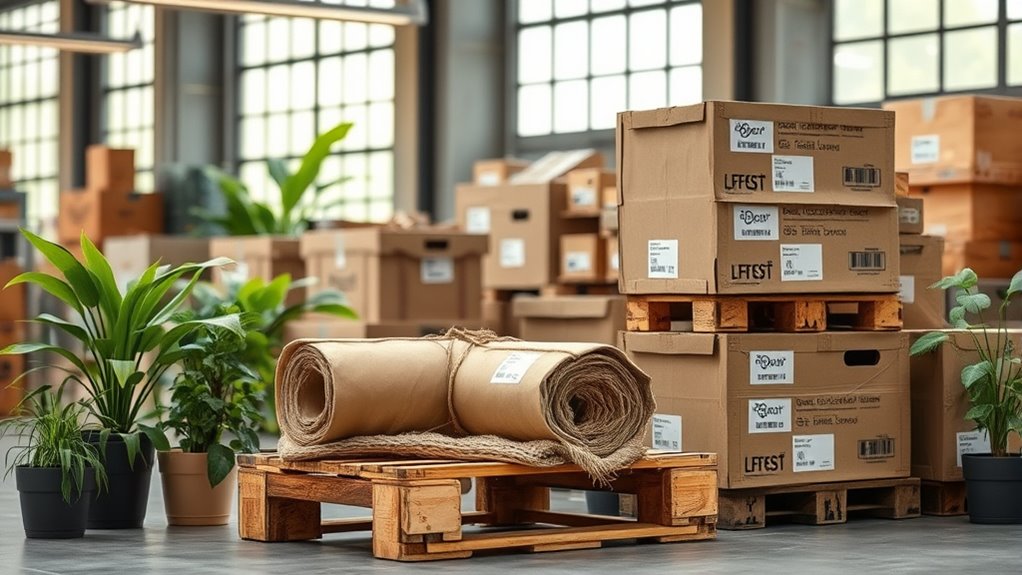
Choosing a green shipping service involves more than just looking for eco-friendly labels; it requires evaluating each provider’s commitment to sustainability. Start by asking if they participate in recycling programs for packaging materials and how they minimize waste. Check if they offer carbon offsetting options to reduce the environmental impact of transportation. A reliable green service will transparently share their efforts to reduce emissions and promote eco-friendly practices. Consider their use of fuel-efficient vehicles or alternative energy sources. Also, look for certifications or partnerships with environmental organizations, which indicate genuine sustainability efforts. By thoroughly appraising these factors, you ensure your rug is shipped responsibly, supporting eco-conscious initiatives while protecting the environment.
Frequently Asked Questions
How Do Eco-Friendly Shipping Options Impact Overall Shipping Costs?
You might wonder how eco-friendly shipping options affect overall costs. While the initial cost comparison could be higher due to sustainable packaging and greener practices, you often save money long-term through environmental savings and reduced waste. These eco-conscious choices can lower your carbon footprint and sometimes qualify you for incentives. Overall, eco-friendly shipping might seem more expensive upfront, but it can lead to cost benefits and positive environmental impacts over time.
Are There Specific Certifications to Look for in Green Logistics Providers?
When choosing green logistics providers, you should look for specific certifications that verify their commitment to sustainability. Certifications like LEED or Green Seal indicate a focus on sustainable packaging and eco-friendly practices. These credentials demonstrate the provider’s dedication to reducing environmental impact, helping you make responsible shipping choices. By selecting a provider with recognized green certification, you ensure your rug shipping aligns with eco-conscious standards and sustainable packaging practices.
Can Eco-Friendly Crating Methods Ensure the Same Level of Protection?
You might wonder if eco-friendly crating methods can protect your rug as well as traditional options. Rest assured, they often do by using recycling materials and biodegradable packaging that provide sturdy protection while reducing environmental impact. Properly designed eco-friendly crates absorb shocks and safeguard your rug during transit. So, with the right choices, eco-friendly crating can guarantee your rug stays safe without compromising on protection.
What Are Common Challenges in Implementing Sustainable Rug Shipping Practices?
Tackling the tricky terrain of sustainable shipping, you face common challenges like recycling obstacles that hinder eco-friendly efforts. Coordinating with suppliers can complicate creating consistent, eco-conscious practices, making change slow and stressful. Balancing the benefits of greener choices with practical problems demands dedication and diligence. By addressing these hurdles head-on, you can transform tough tasks into tangible achievements, fostering a future where sustainability and shipping success go hand in hand.
How Can Consumers Verify the Eco-Friendliness of Shipping Companies?
You can verify a shipping company’s eco-friendliness by checking for environmental certifications like FSC or Green Seal. Ask about their efforts to reduce their carbon footprint, such as using renewable energy or eco-friendly packaging. Review their sustainability reports or website for transparency. Contact the company directly to inquire about their eco-friendly practices. These steps help guarantee you’re choosing a provider committed to reducing environmental impact.
Conclusion
By choosing eco-friendly rug shipping and crating options, you’re planting seeds for a greener future. Think of your efforts as guiding a delicate butterfly safely home—each mindful decision helps preserve our planet’s beauty. Embracing sustainable practices isn’t just a trend; it’s your chance to weave a tapestry of change, protecting the environment one eco-conscious choice at a time. Together, we can turn the shipping process into a gentle ripple of positive impact.



